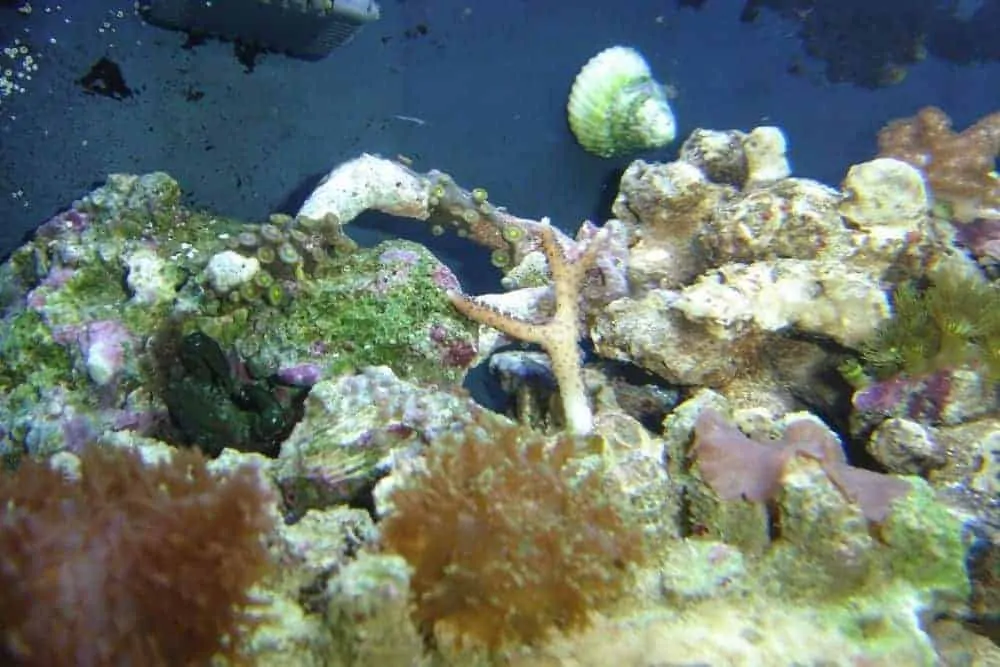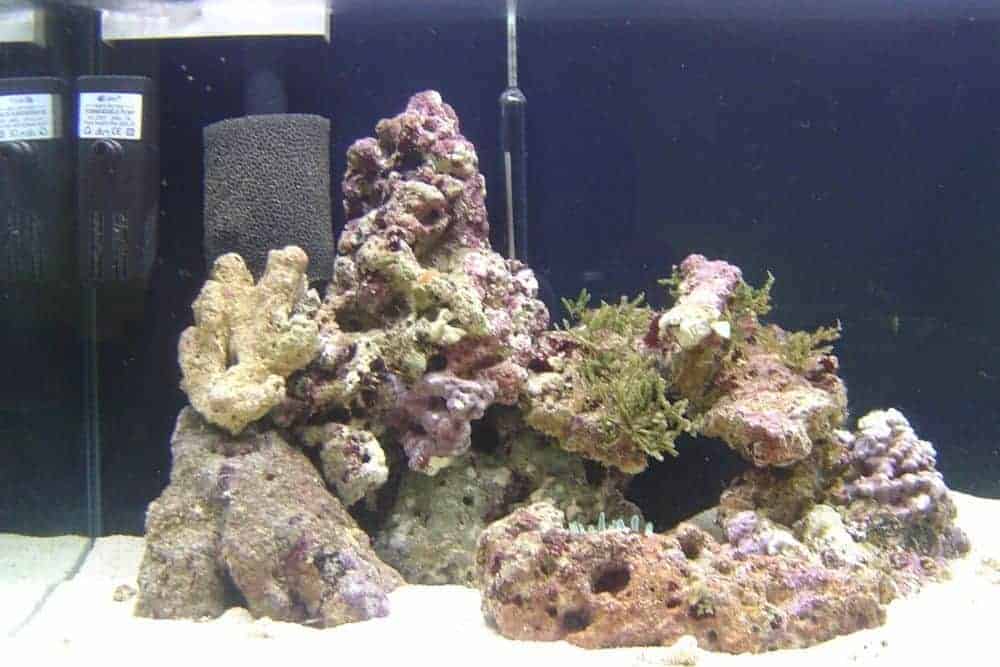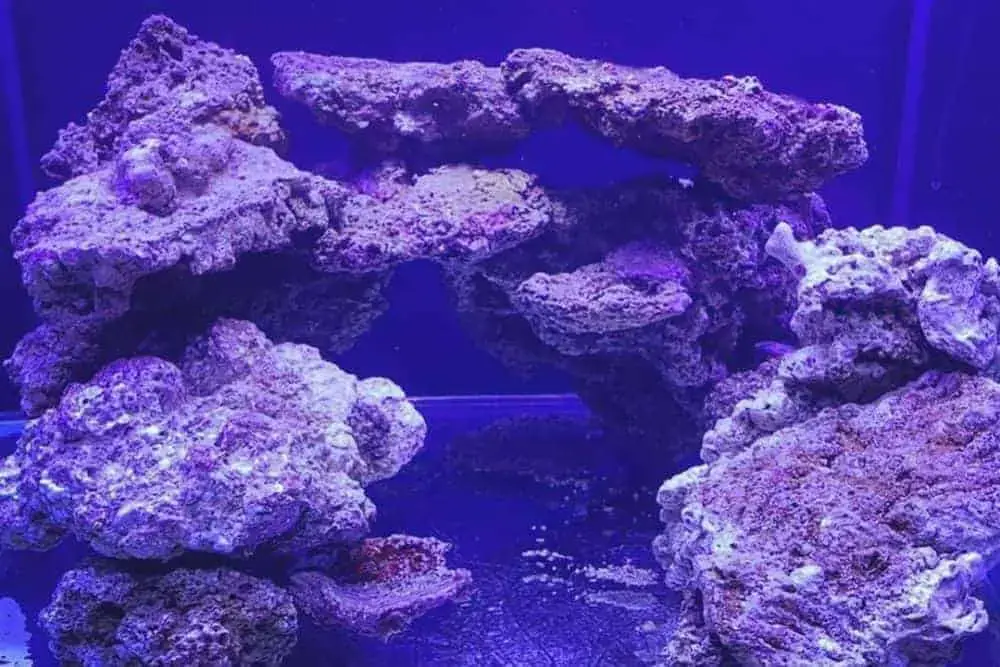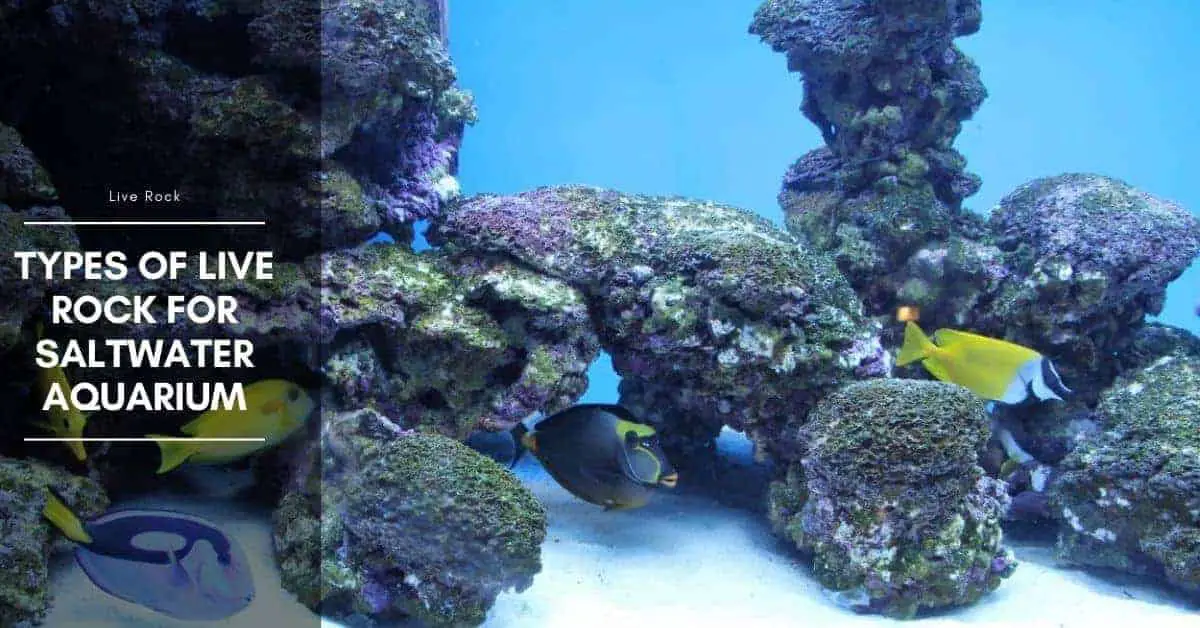Marine aquarists are developing a new appreciation for invertebrates and the physical and biological structure of the marine environment, and live rock is the substrate on which this is built. Live rock can be one of the neatest and most interesting things that one can put in a marine aquarium when done right. It can also bring one of the most costly disasters a marine aquarist can suffer. Let me explain.
First of all, live rock is not alive, it simply contains life. Secondly, there
is nothing magic about live rock. Live rock is just coral rubble, calcareous or other porous rock taken from the waters of a tropical or subtropical area and transported to a marine aquarium system with some or most of the natural microscopic and macroscopic life forms still viable. Most importantly, it contains a constellation of bacteria that can efficiently perform biological filtration in the aquarium.

These bacteria will both nitrify (aerobically convert toxic ammonia to less toxic nitrite and then break down nitrite to relatively harmless nitrate), and denitrify (anaerobically turn nitrate into nitrogen gas, which will exit the system). It does this without prompting, care, or feeding, although it will need good water circulation within the tank to prevent stagnant water layers from developing around the rockwork.
Used properly, good live rock can provide your new marine aquarium with excellent biological filtration almost overnight. Purchased blindly and used without caution, live rock can also produce extreme ammonia spikes and lead to whole-tank wipeouts, leaving every fish and invertebrate dead or dying.
Types of Live Rock
Important considerations and categorizations for live rock are methods
of collection and treatment, composition, structure, and the microscopic
and macroscopic life forms still alive on the rock. The best live rock is
colorful, complex in shape, and porous. Dense, solid, boulder-like pieces
with smooth surfaces are much less desirable. Calcareous pieces formed
by stony corals are perhaps the best.
Premium or fancy rock is an interesting and often very beautiful rock used to top off a new aquascape. Some of the very best rock consists of pieces of old Acropora tables and branches, Porites heads, and other distinctive coral skeletons. Premium rock has been properly handled between collection and final sale to the aquarist, and it will usually display colorful red or pink coralline algae growth—and often other desirable organisms.
Rock that has particular invertebrates or algae attached is often named for the organism. Mushroom anemones, colonial polyps, and Caulerpa, Halimeda, Hypnea, and Bryopsis spp. algae are organisms frequently sold
attached to live rock. Pink and red coralline algae often coat the rock, and tiny growths of filamentous algae such as Cladophora, Chaetomorpha,
Enteromorpha, Boodleopsis, and Derbesia are hidden deep in crevices and
pores. They bloom when good conditions are established and may even become a problem if nutrient levels in the system are too high.

Base rock is a term usually applied to dry pieces of rock, often mined or
gathered from ancient reef formations on tropical islands or coastal areas.
The so-called “Bahamian Reef Rock” is a typical base rock. Although it may
have been high and dry for thousands of years, it will inevitably become colonized by bacteria, coralline algae, crustaceans, and other life forms over a period of months in the aquarium.
It is much cheaper than live rock and can be used to form the first layer of an aquascape, where it may be almost entirely hidden by more pleasing-looking live rock used to dress the top of the reef.
Tetra AquaSafe Plus, 8.45 Ounces, aquarium Water Conditioner And Dechlorinator, Model Number: 46798162681
$8.49 (as of July 14, 2024 06:58 GMT +03:00 - More infoProduct prices and availability are accurate as of the date/time indicated and are subject to change. Any price and availability information displayed on [relevant Amazon Site(s), as applicable] at the time of purchase will apply to the purchase of this product.)API TAP WATER CONDITIONER Aquarium Water Conditioner 16-Ounce Bottle
(as of July 14, 2024 07:00 GMT +03:00 - More infoProduct prices and availability are accurate as of the date/time indicated and are subject to change. Any price and availability information displayed on [relevant Amazon Site(s), as applicable] at the time of purchase will apply to the purchase of this product.)API STRESS COAT Aquarium Water Conditioner 4-Ounce Bottle (85B)
40% OffIt is important to use some rock that has been colonized by bacteria and invertebrates in the sea, but it is not necessary that every rock in the tank come from the bed of the ocean (although this is strongly advised for a dedicated stony coral system). The main trade-off in using some economical base rock to build a reef is the time it takes to develop the tank’s reef versus the initial expense of live rock.
Of course, the more live rock, the greater the kind and quantity of marine life you can introduce to the tank without waiting a period of months. The reef in a system set up with only 10% live rock will take longer to develop than a reef in a system set up with 50-75% or 100% live rock; but within a few months, or perhaps a year or so, the system with less live rock will catch up with the totally transplanted live rock reef system.
Another consideration, however, is that nutrients on the surface of terrestrial rock are not stabilized by bacterial colonies or coralline algae, and hair algae are much more likely to grow on uncured rock. These are options that the reef tank aquarist should consider.
Foundation rock is live rock that has been kept submerged, usually in storage, but is less shapely and more drably colored than better-grade rock
without desirable attached organisms and is usually used to form the basic
hidden structure of the reef in the tank. It lacks the attractive colors of
coralline algae, but comes at a discounted price and is useful in building
the hidden bottom layer of a reefscape. In time it will become indistinguishable from other rock in the aquarium.
Live rocks from Fiji, Tonga, the Marshall Islands, Vanuatu, Indonesia, Bali, Timpora, Irian Jaya, the Solomon Islands, and others
Live rock for the marine aquarium trade is collected from many Indo Pacific island groups, notably Fiji, Tonga, the Marshall Islands, Vanuatu,
Indonesia, Bali, Timpora, Irian Jaya, the Solomon Islands, and others.
Florida has banned wild live rock collection, but maricultured rock is being produced in the Florida Keys and the Gulf of Mexico. Caribbean live rock is available at times, particularly a distinctive platelike type from Haiti consisting of coralline-encrusted blades of old Lettuce Coral skeletons.
Hawaii prohibits live rock collection, and other places have placed limits on its harvest, but many observers believe that the collection of live rock need not harm the environment. Some restrictions on and management of the collection of live rock have been instituted in heavily harvested locations, but rock is very abundant in nature, and there will always be a way to provide active live rock for marine aquarists.
Reef formations and live coral should not be broken up, of course, and all the rock should not be removed from localized, specific areas. Terrestrial rock, usually formed by ancient coral reefs, can be mined from tropical islands and coastal areas, usually from dry inland quarries. Those of appropriate size and composition are placed in the sea and later harvested by collectors, a practice that has proved successful in the Florida Keys and on tracts in the Gulf of Mexico, and perhaps other areas as well.
Hand-formed “rock” composed of crushed coral gravel and sand, coral rubble, and cement, which has been placed in the ocean to age and attract
bacteria, calcareous algae, and many other organisms, is now available and
can be difficult to distinguish from the real thing.
Cured live rock
For someone new to marine aquariums who is setting up a system of modest size, easily the best advice is this: buy your rock from a local aquarium shop and hand-pick the pieces that catch your eye. Buy only “fully cured” rock—that is, live rock that is cleaned of all dead and dying organisms and that is no longer a source of decay and toxic ammonia.
Be sure to ask how long it has been in the dealer’s tanks and look for rock that has been on-site for at least three to four weeks. It will smell clean and of the sea and be free of white or black patches, ready to start performing biological filter duties immediately. If in doubt, pick up and smell the rock.
(If there is any hint of foul odor or rotten egg smell, it is not cured.) Fully cured rock will not be the cheapest rock you can buy, but it will be the safest. You can take it home, put it directly into your new tank, and very likely be stocking a few fish within a matter of days.

How much to buy? The usual recommendations for live rock call for
approximately one to two pounds per gallon of tank volume, but as little
as one pound per 5 gallons can be sufficient to start a 20- to 30-gallon tank.
At one pound per gallon, the rock will offer a rather sparsely filled, open aquascape. Two pounds per gallon gives more opportunity to create interesting reef topography.
Some aquascapers recommend buying an odd number of pieces for a small tank. Start with three and you have the makings of a cave or small island, with two foundation rocks and a capstone placed atop. Live rock makes the most effective biological filter when water currents can swirl around the rock and through the reef.
Try not to stack your rock tightly. The “stone wall” look is both unnatural and less than optimal for the biological filter and the fishes, who appreciate all manner of holes, crevices, and niches for shelter.
Uncured live rock
Starting with uncured rock makes a whole different set of demands on the
aquarist. You can easily find a source of “cheap” live rock by the boxful, but you will likely find that the time and expense of curing it yourself can add considerably to the cost.
First, never add just-shipped rock directly to an established aquarium.
Dry shipping, even of cured rock, usually requires a period of transition
to be sure that the incoming rock is not a source of ammonia. Uncured rock placed in an established home aquarium can fill a house with the unmistakable odor of rotting animal flesh. Family members will be up in
arms, but the inhabitants of the tank will be gasping at the surface, lying
on the bottom, showing red streaks indicative of internal bleeding, and
almost surely dying.
When the aquarist gets it, every live rock has a particular ratio of living organisms to dead organic matter. The more living organisms and the less dead organic matter, the better the live rock is for the aquarium system.
Dead organic matter brought into the system with the rock must be mineralized by heterotrophic bacteria and oxidized by nitrifying bacteria, and this results in increased nitrate levels that have to be handled by the system or by water changes. Live organisms, if they survive, grow and reproduce and aid the function of the system.
The ratio of living to dead material depends on the amount of dead organic matter in the rock when it was collected, how the process of collection and transportation affected life on and in the rock (this includes time out of the water, exposure to heat and cold, and degree of desiccation), and whether or not, and how carefully, the rock was cleaned.
All these considerations determine how soon the rock will add to the biological balance of the tank, and whether it will contribute algal and invertebrate growths to the tank’s inhabitants.

Hi, my name is Sean, and I’m the primary writer on the site. I’m blogging mostly about freshwater and saltwater aquariums, fish, invertebrates, and plants. I’m experienced in the fishkeeping hobby for many years. Over the years I have kept many tanks, and have recently begun getting more serious in wanting to become a professional aquarist. All my knowledge comes from experience and reading forums and a lot of informative sites. In pursuit of becoming a professional, I also want to inspire as many people as I can to pick up this hobby and keep the public interest growing.
Read more about Sean.
Please join also my Facebook group.




















2 thoughts on “Types of Live Rock for Saltwater Aquarium”
Comments are closed.